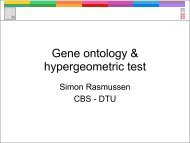Computational tools and Interoperability in Comparative ... - CBS
Computational tools and Interoperability in Comparative ... - CBS
Computational tools and Interoperability in Comparative ... - CBS
Create successful ePaper yourself
Turn your PDF publications into a flip-book with our unique Google optimized e-Paper software.
4 O. N. Reva et al.<br />
decrease of the base stack<strong>in</strong>g energy. Figure 4 visualizes<br />
the phylogenetic relationships differentiated by TU patterns<br />
of 29 g-Proteobacterial taxa each of which represented<br />
by not more than a s<strong>in</strong>gle sequenced stra<strong>in</strong>.<br />
A. borkumensis forms a cluster with Pseudomonas,<br />
Methylococcus, Xanthomonas <strong>and</strong> Xylella (Fig. 4).<br />
Despite the variation <strong>in</strong> GC-content, from 52 to 54% <strong>in</strong><br />
Xylella <strong>and</strong> Alcanivorax to more than 65% <strong>in</strong> Xanthomonas<br />
<strong>and</strong> Pseudomonas, the TU patterns of these<br />
Fig. 3. Tetranucleotide usage patterns of<br />
A. borkumensis SK2, P. putida KT2440, E. coli<br />
K12 MG1655 <strong>and</strong> S. oneidensis MR-1. The<br />
deviation Dw of observed from expected<br />
counts is shown for all 256 tetranucleotide<br />
words (16 ¥ 16 cells) by colour code (right<br />
bar). Tetranucleotides are grouped <strong>in</strong>to 39<br />
classes of equivalent structural features (Baldi<br />
<strong>and</strong> Baisnee, 2000) <strong>and</strong> sorted by decreas<strong>in</strong>g<br />
base stack<strong>in</strong>g energy row-by-row start<strong>in</strong>g at<br />
the upper left corner (class 39). The words<br />
correspond<strong>in</strong>g to the cells <strong>in</strong> colour plots are<br />
shown <strong>in</strong> the table <strong>in</strong> lower part of the figure.<br />
microorganisms are similar <strong>and</strong> separated from other<br />
g-Proteobacteria. There is an abundance of GC-rich tetranucleotides<br />
with high base stack<strong>in</strong>g energy <strong>in</strong> the<br />
sequence of A. borkumensis SK2 (words belong<strong>in</strong>g to<br />
equivalence classes 37–39, 30 <strong>and</strong> 27) that is similar to<br />
the TU pattern of P. putida KT2440 (Fig. 3). Words of the<br />
AT-rich classes 7, 10, 13 <strong>and</strong> 32 are significantly underrepresented<br />
<strong>in</strong> both species. The major difference<br />
between TU patterns is the abundance of poly A <strong>and</strong> poly<br />
©2007TheAuthors<br />
Journal compilation © 2007 Society for Applied Microbiology <strong>and</strong> Blackwell Publish<strong>in</strong>g Ltd, Environmental Microbiology









